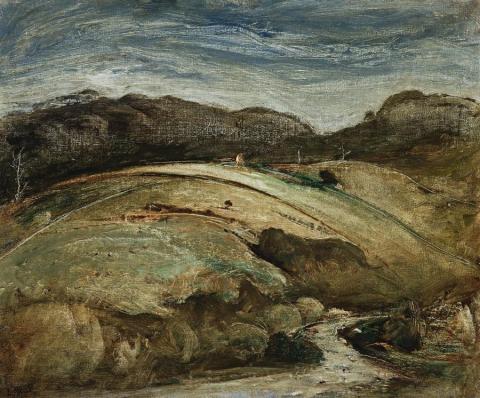LANDSCAPE, 1945
LLOYD REES
oil on canvas on board
37.0 x 44.5 cm
signed and dated lower left: L REES / 45
Mr and Mrs Douglas Carnegie, New South Wales
Brigadier R.W.P. Dodd, MC (CMF), Queensland
Thence by descent
Estate of Molly Dodd, Queensland
Lloyd Rees Retrospective, Art Gallery of New South Wales, Sydney, 2 October – 2 November 1969, cat. 35, then touring to Queensland Art Gallery, Brisbane, November – December 1969; National Gallery of Victoria, Melbourne, 1 – 28 February 1970; Tasmanian Museum and Art Gallery, Hobart, 17 March –13 April 1970; Art Gallery of South Australia, Adelaide, 1–31 May 1970; Art Gallery of Western Australia, Perth, 18 June – 21 July 1970; and Newcastle Regional Gallery, New South Wales, 1 – 31 August 1970 (label attached verso, lent by Mr and Mrs Douglas Carnegie, New South Wales)
Free, R., Lloyd Rees, Lansdowne Press, Melbourne, 1972, cat. O99, p. [112], (illus.)
The distinguished history of a work of art gives it special significance, a lustre in the present and honour in the future. So it is with this little gem by Lloyd Rees - painted during a vintage period; first purchased by one of the most discerning collectors of the day; and selected by the artist himself to be included in his memorable retrospective exhibition assembled by the Art Gallery of New South Wales to tour Australia in 1969-70. The exhibition revealed the grandeur of Rees's vision so in harmony with the lyrical appeal of nature. Rees is a painter's painter. Brett Whiteley admired the way in which his paintings are 'completely real descriptions, yet abstract at the same time'.1 Of his works of evening, John Olsen wrote of their 'sombre elegiac tonalities that induced a feeling of a warm earth regretfully saying farewell to an evening sky'.2
While Rees's images often dwell on Olympian heights, he opens them up for all to enjoy through his mastery of the shared experience and the humanism with which they areimbued. The secluded moments, as in our painting, are just as special. Only a work of outstanding quality could get away with such a bland title as 'Landscape'. But the artist's intentions are clear and engaging, avoiding external associations, of location or narrative, to concentrate on the captured beauty of the vision. The swell of the land speaks of promise and plenitude, the earth watered by the stream flowing below as all is bathed in an atmosphere of pastoral peace. Technique and imagery harmonise as the easy gesture of the brush celebrates the broad sweep of the land. Drawn to the rhythms of the landscape, Rees commented, 'Subconsciously I've felt the hills have made me think of the feminine form - rhythm associated with figure and landscape.'3 The landscapes of Gerringong, Orange and Bathurst, had a special appeal for Rees, his wife Marjory having come from the latter. One recalls the earlier Evening on the Bathurst Hills, 1936 (Art Gallery of New South Wales, Sydney), September Landscape, Orange, 1944 (formerly Mrs John Baillieu, Melbourne), and Evening Landscape, Gerringong, 1946 (Art Gallery of New South Wales), all three being in Rees's 1969 retrospective. Together with Landscape, 1945, each is a work of unique beauty. Though inspired by the Australian scene, they are universal in their appeal, each possessing an inner life springing from the translation of the descriptive into the creative, enveloped by an atmosphere of gentle lyricism.
1. Whiteley, B., quoted in Artists Salute Lloyd Rees on the occasion of his ninetieth birthday [catalogue], Macquarie Galleries, Sydney, 1985, p. 7
2. Olsen, J.,'Road to Berry', Art and Australia, vol. 5, no. 3, December 1967, p. 544
3. The artist, Free, R., Lloyd Rees, Lansdowne Press, Sydney, 1985, p. 51
DAVID THOMAS
